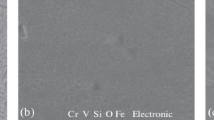Abstract
Time dependences of spalling strength and critical specific fracture energy of some metals under a thermal shock initiated by x‐rays of a nuclear explosion are obtained. Under thermal‐shock conditions, the durability of metals decreases exponentially as the amplitude of the fracture stress increases. The critical specific fracture energy of metals subjected to a thermal shock increases with the duration of tensile stresses. Using an example of cones, conical shells, disks, and rods, it is shown that the geometric factor should be taken into account, which can reduce the fracture threshold and increase the degree of fracture of an object subjected to a thermal shock. This is a result of stress cumulation, occurrence of cumulative ejection of the material, and stability loss due to the action of powerful energy fluxes.
Similar content being viewed by others
REFERENCES
S. Eliezer, I. Gilath, and T. Bar-Noy, “Laser-induced spall in metals: Experiment and simulation,” J. Appl. Phys., 67, No. 2, 715–724 (1990).
Physics of Nuclear Explosion, Vol.2: Explosive Action [in Russian], Fizmatlit, Nauka (1997).
V. N. Aptukov, “Deformation and failure of a plate under a thermal shock,” Probl. Prochn., No. 12, 82–87 (1987).
E. K. Bonyushkin, B. L. Glushak, N. I. Zavada, et al., “Mechanisms of spalling of metals in the fast spaceheating regime in submicrosecond and submillimicrosecond ranges of durability,” J. Appl. Mech. Techn. Phys., 37, No. 6, 862–870 (1996).
V. K. Golubev, K. G. Rabinovich, and A. K. Chernyshev, “Special features of failure of copper foil under intense x-ray irradiation,” Zh. Tekhn. Fiz., 68, No. 2, 116–117 (1998).
A. M. Molitvin, I. P. Borin, and V. S. Bosamykin, “Durability of copper, nickel, titanium, brass, and bronze under impulsive irradiation,” J. Appl. Mech. Tech. Phys., 37, No. 6, 871–875 (1996).
I. P. Borin, V. S. Bosamykin, and A. M. Molitvin, “Durability of copper and its alloys under a pulsed electromagnetic action,” Fiz. Met. Metalloved., 81, No. 5, 170–175 (1996).
A. M. Molitvin and I. P. Borin, “Special features of spalling fracture of metals under a thermal shock,” Metally, No. 3, 93–98 (1998).
A. M. Molitvin, “Kinetic and energy approaches to the description of spalling fracture of copper and nickel under a thermal shock,” Metally, No. 3, 101–108 (2001).
A. M. Molitvin, “Kinetic and energy approaches to the description of spalling fracture of structural steels under a thermal shock,” Metally, No. 4, 66–71 (2002).
A. M. Molitvin, “Strength and speci_c fracture energy of metals subjected to a thermal shock,” in: V. E. Fortov (ed.), Physics of Extremal States of a Substance [in Russian], Chernogolovka (2002), pp. 121–123.
A. M. Molitvin, I. P. Borin, and V. S. Bosamykin, Some geometrical effects of thermomechanical failure of metallic specimens under pulsed radiation,” J. Appl. Mech. Tech. Phys., 37, No. 5, 751–755 (1996).
E. N. Donskoi, “Algorithm and program _ELIZA for solving problems of compatible transfer of-radiation, electrons, and positrons by the Monte Carlo method,” Vopr. Atom. Nauki Tekh., Ser. Mat. Model. Fiz. Prots., No. 1, 3–6 (1993).
G. G. Ivanova, N. F. Gavrilov, V. I. Selin, and V. N. Safonov, “UP-OK program for solving one-dimensional problems of mechanics of continuous media in the one-dimensional complex,” Vopr. Atom. Nauki Tekhn. Ser. Met. Progr. Chisl. Resh. Zad. Mat. Fiz., No. 3, 11–14 (1982).
I. P. Borin, S. A. Novikov, A. P. Pogorelov, and V. A. Sinitsyn, “Kinetics of fracture of metals in the subsecond range of durability,” Dokl. Akad. Nauk SSSR, 266, No. 6, 1377–1380 (1982).
A. G. Ivanov and V. N. Mineev, “Scale criterion of brittle fracture of structures,” Dokl. Akad. Nauk SSSR, 220, No. 3, 575–578 (1975).
V. A. Ogorodnikov, A. G. Ivanov, V. I. Luchinin, et al., “Scaling effect in dynamic fracture (spallation) of brittle and ductile materials,” Combust. Expl. Shock Waves, 35, No. 1, 97–102 (1999).
Author information
Authors and Affiliations
Rights and permissions
About this article
Cite this article
Molitvin, A.M. Strength and Specific Fracture Energy of Metals Subjected to a Thermal Shock. Journal of Applied Mechanics and Technical Physics 44, 135–140 (2003). https://doi.org/10.1023/A:1021750301736
Issue Date:
DOI: https://doi.org/10.1023/A:1021750301736




